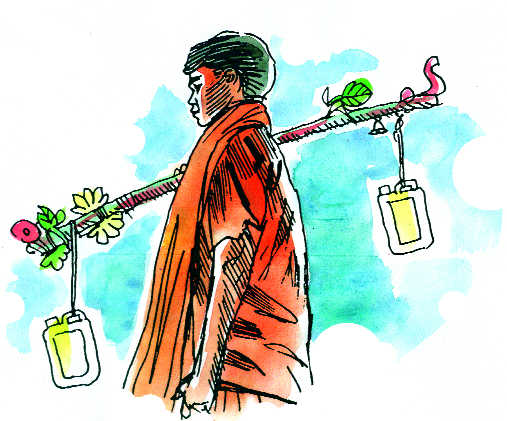Sandeep Sinha
Sawan Ka Mahina Pawan Kare Shor…went the popular song sung by Mukesh. Unfortunately, the three Somvars (Mondays) of the month of Sawan have passed but Chandigarh is yet to see either Sawan in its full flow or the related shor in the form of thundering skies, lightning flashing and rain drops descending in a constant drizzle. The Met Department has in fact said that there has been 48 per cent less rainfall in the city. Hopes of a rimjhim gire sawan have started receding slowly.
But Sawan is one month that fails to dampen the spirit of the devout. It is time for a saffron surge, with people setting out in large numbers on a pilgrimage, fetching the waters of the Ganga and travelling back on foot to offer the Gangajal to Lord Shiva. The rigour of the Kanwariyas cleanses the self and the piety bonds people across castes and classes. If religion created schisms, the month of Sawan is one opportunity where the social differences get peppered over, cemented by devotion for a deity who is himself an ascetic and a non-conformist of sorts given his penchant for bhang and dhatura.
Having spent 18 years of my early life in a temple town, a part of the 12 Jyotirlingas, Sawan evokes fond memories in me. It was that time when the town would brace for the congregation that descended to offer the holy Ganga water to Lord Shiva. The earnings during the month was said to keep the pot boiling for many residents of the town for the rest of the year.
Hotels and eating joints would spring up and people would rent out accommodation to make hay while the Sawan sun shone. Shops and business establishments would remain open till late at night and special trains and buses plied in large numbers. The whole town would discover a new idiom of life and the town would be abuzz 24X7.
We lived in a house with a compound and in Sawan, it would be occupied by Kanwariyas who would look for any space to pitch tent. “Baba Ka Bagiya Hai,” (it is the Lord’s garden), would be their refrain. It would be a celebration of sorts with the Kanwariyas cooking and singing bhajans. A camaraderie would develop. Cries of Bol Bam Ka Nara Hai, Baba Ek Sahara Hai rent the air.
My favourite memory is of a Hari Om Sharan bhajan being played on the temple loudspeaker at the crack of dawn, “Maili chadar odh ke kaise, dwar tumhare aaun; He pawan parmeshwar mere, man hi man sharmaun.” Inside the precincts, there would be long queues waiting for their turn to enter the sanctum sanctorum.
The Kanwariyas came in all hues. There was a category called the “Dak Bam” that would make its trek uninterruptedly without a halt. They would be granted access immediately because of the rigour of their journey. Then there was a category that would make the journey by travelling prostrate. It would be a kind of penance and took time.
The Kanwariyas would prefer to walk while it was raining. It would make their journey slightly smooth. Many would prefer to rest during the day and travel at night. A sort of competitive air would prevail with groups bragging about how quickly they made their trip. The journey, bare feet, was no easy task, with blisters in the legs a normal occurrence.
In Chandigarh, at the temple in the area where I live, residents offer prasad in the form of chips, chocolates, muffins, cakes, biscuits and juice during the month of Sawan.
In fact, the Shivalinga was decorated with blue Lays chips packets on one occasion. I was reminded of a folk song, “Puri kachori Shiv ke na bhave, kahe se Shiva ke manayab ho, Shiv manat nahin.” (Shiva does not like puri, kachori, what shall I try to cajole him?).
Times, they are indeed a-changin’.
Unlock Exclusive Insights with The Tribune Premium
Take your experience further with Premium access.
Thought-provoking Opinions, Expert Analysis, In-depth Insights and other Member Only Benefits
Already a Member? Sign In Now











